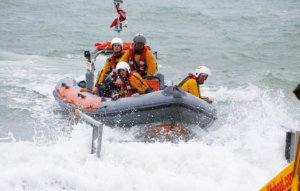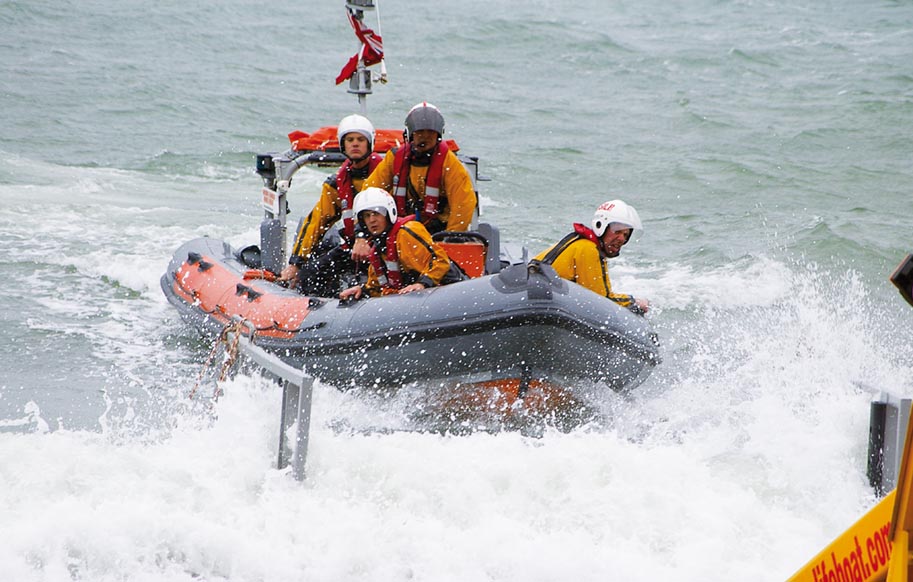 They come from all walks of life, but have one common goal. The volunteers who make up the crew of Sandown and Shanklin Independent Lifeboat suddenly put aside their day jobs when the need arises to perform courageous and sometimes heroic tasks in perilous conditions. “We’ve got builders, tilers, caterers, labours and even a lawyer,” smiled Mark Birch, coxswain for the past 15 years of the lifeboat, which is stationed some 300 yards south of Sandown Pier.
They come from all walks of life, but have one common goal. The volunteers who make up the crew of Sandown and Shanklin Independent Lifeboat suddenly put aside their day jobs when the need arises to perform courageous and sometimes heroic tasks in perilous conditions. “We’ve got builders, tilers, caterers, labours and even a lawyer,” smiled Mark Birch, coxswain for the past 15 years of the lifeboat, which is stationed some 300 yards south of Sandown Pier.
Mark can call on 16 crew members, two shore helpers, five fund-raisers and even a padre, who all give up their valuable time for free to try to ensure the waters around the Island remain a safe haven. But when the emergency call comes they unite to form a close-knit and well-drilled team to provide invaluable aid to those in difficulty.
The Sandown and Shanklin Lifeboat, whose chairman is Ron Teasdale, is one of three independent lifeboats on the Island. Like the other two, located at Ryde and Freshwater, it is funded solely by charitable donations. “We have absolutely no administration charges, and everything that is raised goes towards the upkeep of our lifeboat, the station, equipment and the tractor that is needed to help launch and bring the boat back out of the water,” emphasised Mark, who revealed that £16,000 has to be found each year just to keep the operation afloat.
There has been an independent lifeboat around Sandown Bay since the 1880s. The current station has been its home for 40 years, and the boat – an Atlantic 21 Rigid Inflatable Boat (RIB) – is more than 20 years old. It is set to be replaced next year with a more modern version, and when funds, and hopefully a lottery grant are forthcoming, a new £180,000 station will be built on land adjacent to the current one. But that could still be at least two years away.
Meanwhile, Mark and his crew operate from their cramped station, meeting once a week for practice, then downing tools and racing back there when the emergency call comes in. Sandown alone answer up to 50 calls a year. They can vary from people getting into difficulty on inflatables, divers going missing, mechanical breakdowns, adventurers getting caught on the cliffs when the tide comes in, and even stranded dolphins.
“The sea has to be treated with respect, but too many take in for granted,” said Mark. “You often find holidaymakers coming down with their little boats, but with no real knowledge of the sea and then getting into difficulty.” Sometimes with tragic consequences. Sadly, one such case was highlighted when a couple were swept out to sea off Culver Down three years ago. Mark and his crew spent 13 hours searching for them on the day they disappeared, and were then back out at dawn for a further seven-hour stint. They recovered one body, and a second was washed ashore some days later.
Thankfully for each mission that ends in tragedy, there are many that end in triumph. Mark recalls: “Once a couple rushed into the station to say their nine-year-old daughter had been swept out to sea on a rubber ring. We launched, and eventually found her detached from the ring and about a foot under the water, eyes wide open and in a poorly condition.
 “We managed to haul her on to our boat and give her first aid to bring her back to life. She was taken to hospital by ambulance to get checked over, and to our surprise, later that day she and her parents came back to the station to thank us for saving her life.
“We managed to haul her on to our boat and give her first aid to bring her back to life. She was taken to hospital by ambulance to get checked over, and to our surprise, later that day she and her parents came back to the station to thank us for saving her life.
“It is times like that, when people come back to say thank you, and often make a donation, that gives us the greatest satisfaction of all, and makes the job so worthwhile.”
Off a coastline that varies from so dramatically, the Sandown and Shanklin Independent Lifeboat covers an area up to 10 miles out at sea, from Bembridge Ledge to St. Catherine’s point. But they travel much further if the need arises. The RIB usually carries three or four crewmen for each mission and travels up to 36 knots an hour.
Mark and his crew have been known to encounter horrendous conditions including Force Nine gales. He smiled: “We were out on a Force 10 storm once. It was a bit windy, but didn’t affect the boat too much. However, we couldn’t go flat out!”
There was one occasion – the only one so far – when an emergency landed literally on their doorstep. A pilot, competing in the annual Schneider Trophy, ran out of fuel and had to ditch his plane on Sandown beach right outside the station. “We were manning the station at the time, so we were definitely first on the scene,” said Mark. “The pilot was fine, and we managed to pull the plane out of the sea before the tide came in. He was very thankful for the help we gave him, and later made a donation of £200. The one thing about being a crew member is that you know every job is going to be different, and you never really know what to expect until you arrive at the scene.”
Sandown and Shanklin Lifeboat, like Ryde and Freshwater, often work closely with the RNLI boats on the Island. But as independent lifeboats they are grateful for all the financial help they receive, and the recent introduction of Go Orange Day has done much to publicise their cause.
When not going about their day jobs, or carrying out rescue missions, the Sandown crew are out raising funds in whatever way they can. Members visit schools, clubs, businesses and groups to give talks and laptop slideshows about the work they carry out. “We try to show all aspects of the work we do, whether it is sad, happy or somewhere in between,” added Mark. More information about Sandown and Shanklin Lifeboat, and how anyone can make a donation, can be found on website sandownlifeboat.com



